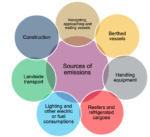Archives
Business, Freight News, Sea
Optimized Port Calls Would Cut GHG
[ June 19, 2024 // Gary G Burrows ]SMART port technologies that facilitate ‘just in time’ ship arrivals could significantly reduce greenhouse and pollutant gas emissions at global container ports, Drewry said in its latest quarterly Ports and Terminals Insight report.
Investing in such technologies at ports with a disproportionate amount of waiting time will generate the highest benefits for the industry, the research and consulting service said.
Shipping accounts for nearly 3 percent of global greenhouse gas (GHG) emissions, and ports and ocean vessels calling the port are a major GHG contributor to GHG and pollutant emissions, Drewry said. These vessels at anchor or at berth concentrate the emissions.
Ports need to serve as facilitators of decarbonizing the shipping industry, and initiatives to reduce emissions are essential. Considering ocean-going vessels, navigating, approaching and waiting are the key areas where emissions savings could be made.
Drewry analyzed the performance of 193 of the world’s largest container ports, accounting for 85 percent of global trade, and showed that pre-berth waiting time remained 40 percent above 2019 levels. It also found considerable regional variation, driven by differences in traffic levels and port congestion.
Container berths are usually allocated pre-booked slots, with multi-port schedules developed to enable on-time arrival at each port. Drewry found that, that despite the recovery from supply chain disruptions during the pandemic, many vessels continue to operate on a ‘sail-fast-then-wait’ basis, which results in the earliest arrival time at the port, whether a berth is available or not.
Just in time arrival systems reduce waiting by aligning vessel speed on inbound voyages with berth availability. They support speed reduction, reduce fuel consumption and emissions on the main voyage and reduce the time spent generating emissions at port anchorage zones.
Pre-berth waiting delays vary widely between ports, Drewry found, based on a combination of both total pre-berth waiting time and average pre-berth waiting time per 1,000 TEU port throughput.
Potential Benefits
Illustrating the potential benefits of JIT arrival systems, Drewry analyzed Dar es Salaam, where in 2023 vessels waiting at anchor for more than a week accounted for almost 70 percent of total waiting time incurred at the port – or almost 2,000 days.
“We looked at what effect reducing the average speed on the inbound voyage would have on time spent in the port’s anchorage zones (speed reduction only applied to vessels incurring 8 hours or more of waiting time upon arrival at the port),” Drewry said.
Capping average inbound voyage speed to 10 knots during congested periods would have resulted in waiting time savings of 31 percent, equivalent to 23,000 CO2eq of emissions. A more conservative scenario, which capped inbound voyage speed at 12 knots generated waiting time savings of 16 percent (or 11,800 CO2eq).
As shipping services typically call multiple ports in a coastal or regional port ranges, Drewry said ports should coordinate to reduce respective emissions, particularly where voyage durations are relatively short, such as on the U.S. East Coast. Vessels would be given notice of berth availability conditions for their next port of call before departing their current call.
Drewry analyzed vessels departing from the port of Norfolk heading south for Savannah, 450 nautical miles to the south. Selective speed reduction to achieve a 10-knot average speed during congested periods could have reduced pre-berth waiting at Savannah by 24 percent, equating to a saving of almost 7,250 tonnes CO2eq. A 12-knot threshold would have generated waiting time savings of 6 percent or 1,800 tonnes CO2eq.
JIT arrival systems require integration of port, terminal and carrier management systems, as well as interfacing with other service providers that support ship arrivals and departures at each port. Organizational challenges to implementing these systems are high, especially in emerging markets. Many ports with the greatest potential to benefit are least prepared to implement the solutions, Drewry said.
JIT arrival systems are well placed to deliver emissions reduction in the near term, and targeting investment towards ports with a disproportionate amount of waiting time will generate the highest benefits for the industry, Drewry said.
Drewry’s Port and Terminal Insight is available at https://www.drewry.co.uk/.

Tags: Drewry’s Port and Terminal Insight








